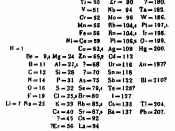Electrolysis
*First Law
The quantity of a substance produced by electrolysis is proprotional to the quantity of electricty used.
*Second Law
For a given quantity of electricity the quantity of substance produced is proportional to its weight.
*The quantity of electricity or charge contained in a current running for a specified time can be calculated: Q = I x t
Q = quantity of electricity or charge in coulombs (C)
I = current in amps (A)
t = time (seconds)
*The Faraday constant, F, is the quantity of electricity carried by one mole of electrons.
F = Avogadro's Number x charge on electron in coulombs
F = 6.022 x 1023 mol-1 x 1.602192 x 10-19 C
F = 96,484 C mol-1
This is usually rounded off to 96,500 C mol-1 for calculations in chemistry.
*The quantity of electricity required to deposit an amount of metal can be calculated: Q = n(e) x F
Q = quantity of electricity in coulombs (C)
n(e) = moles of electrons
F = Faraday constant = 96, 500 C mol-1
*Electrical Energy, E, can be calculated: E = Q x V
E = electrical energy in joules (J)
Q = quantity of electricity in coulombs (C)
V = voltage (or EMF) in volts (V)
*1 kilowatt-hour, kWH, is a unit of electrical energy.
1 kWH = 3.6 x 106 J
Examples
*Q = I x t
Calculate the quantity of electricity, Q, obtained when a current of 25 amps runs for 1 minute.
Q = ? C
I = 25 A
t = 1 minute = 60 seconds
Q = 25 x 60 = 1,500 C
Calculate the current needed to 30,000 coulombs of electricity in 5 minutes.
Q = 30,000 C
I = ? A
t = 5 minutes = 5 x...


Very helpful
Thanks a lot for this one, worked examples were very helpful for me.
0 out of 0 people found this comment useful.